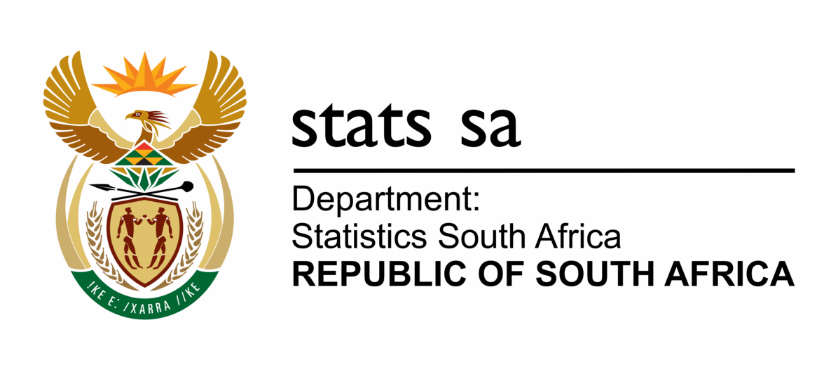Key findings: P0441 - Gross Domestic Product (GDP), 4th Quarter 2024
GDP increased by 0,6% in the fourth quarter of 2024
Gross domestic product (measured by production)
South Africa’s gross domestic product (GDP) increased by 0,6% in the fourth quarter of 2024, following a decrease of 0,1% in the third quarter of 2024.
The agriculture, forestry and fishing industry increased by 17,2%, contributing 0,4 of a percentage point to the positive GDP growth. This was primarily due to increased economic activities reported for field crops and animal products.
The finance, real estate and business services industry increased by 1,1%, contributing 0,3 of a percentage point. Increased economic activities were reported for financial intermediation, real estate activities and other business services.
The trade, catering and accommodation industry increased by 1,4%, contributing 0,2 of a percentage point. Increased economic activities were reported for wholesale trade, retail trade and motor trade.
The transport, storage and communication industry decreased by 1,0%, contributing -0,1 of a percentage point. Decreased economic activities were reported for land transport and transport support services.
The manufacturing industry decreased by 0,6%, contributing -0,1 of a percentage point. Six of the ten manufacturing divisions reported negative growth rates. The largest negative contributions were reported for the basic iron and steel, non-ferrous metal products, metal products and machinery division and the motor vehicles, parts and accessories and other transport equipment division.
General government services decreased by 0,5%. This was mainly due to decreased employment in national and provincial government and extra-budgetary institutions.
The electricity, gas and water industry decreased by 1,4%. This was largely due to decreases in electricity production and consumption.
The mining and quarrying industry decreased by 0,2%. Decreased economic activities were reported for manganese ore and iron ore.
Expenditure on GDP
Expenditure on real GDP increased by 0,6% in the fourth quarter of 2024, following a decrease of 0,1% in the third quarter of 2024.
Household final consumption expenditure (HFCE) increased by 1,0%, contributing 0,6 of a percentage point to the total growth. Positive growth rates were reported for semi-durable, durable and non-durable goods.
The main positive contributors to the increase in HFCE were expenditures on clothing and footwear (4,4% and contributing 0,2 of a percentage point), food and non-alcoholic beverages (1,4% and contributing 0,2 of a percentage point), recreation and culture (2,5% and contributing 0,2 of a percentage point), furnishings, household equipment and maintenance (1,9% and contributing 0,1 of a percentage point), ‘other’ (0,9% and contributing 0,1 of a percentage point), health (1,2% and contributing 0,1 of a percentage point) and alcoholic beverages, tobacco and narcotics (1,4% and contributing 0,1 of a percentage point).
The negative contributors were expenditures on transport and restaurants and hotels.
Final consumption expenditure by general government decreased by 0,8%, contributing -0,2 of a percentage point to the total growth. This was mainly driven by decreases in purchases of goods and services and compensation of employees.
Gross fixed capital formation decreased by 0,7%, contributing -0,1 of a percentage point to the total growth. The negative contributors to the decrease were residential buildings (-7,5% and contributing -0,9 of a percentage point), machinery and other equipment (-1,3% and contributing -0,5 of a percentage point) and non-residential buildings (-2,7% and contributing -0,2 of a percentage point).
There was a R16,4 billion drawdown of inventories (seasonally adjusted and annualised value). Large decreases in two industries, namely mining and trade, catering and accommodation, contributed to the inventory drawdown.
Net exports made a neutral contribution (0,0 percentage points) to expenditure on GDP. Exports of goods and services increased by 2,1%, largely influenced by increased trade in pearls, precious and semi-precious stones and precious metals; and chemical products.
Imports of goods and services increased by 2,0%, largely influenced by increased trade in vehicles and transport equipment excluding large aircraft; vegetable products; and machinery and electrical equipment.
Key findings for the annual estimates of 2024
Real GDP measured by production in 2024
Real GDP increased by 0,6% in 2024, following an increase of 0,7% in 2023.
The annual increase in real GDP of 0,6% in 2024 was primarily led by higher economic activities in finance, real estate and business services (3,5% and contributing 0,8 of a percentage point), personal services (1,7% and contributing 0,3 of a percentage point) and electricity, gas and water (3,5% and contributing 0,1 of a percentage point).
The agriculture; construction; trade; transport; manufacturing; and general government services industries recorded negative growth in 2024.
Expenditure on GDP in 2024
Expenditure on GDP increased by 0,6% in 2024, following an increase of 0,7% in 2023.
Household final consumption expenditure increased by 1,0%, contributing 0,7 of a percentage point.
The main positive contributors to the growth in HFCE were expenditures on food and non-alcoholic beverages (2,3% and contributing 0,3 of a percentage point), furnishings, household equipment and maintenance (3,4% and contributing 0,2 of a percentage point), recreation and culture (2,9% and contributing 0,2 of a percentage point), health (2,4% and contributing 0,2 of a percentage point), restaurants and hotels (3,1% and contributing 0,2 of a percentage point) and communication (2,8% and contributing 0,2 of a percentage point).
Gross fixed capital formation decreased by 3,7%, contributing -0,5 of a percentage point and changes in inventories contributed -1,0 percentage point to the total growth.
Net exports contributed 1,3 percentage points to the total growth in expenditure on GDP

